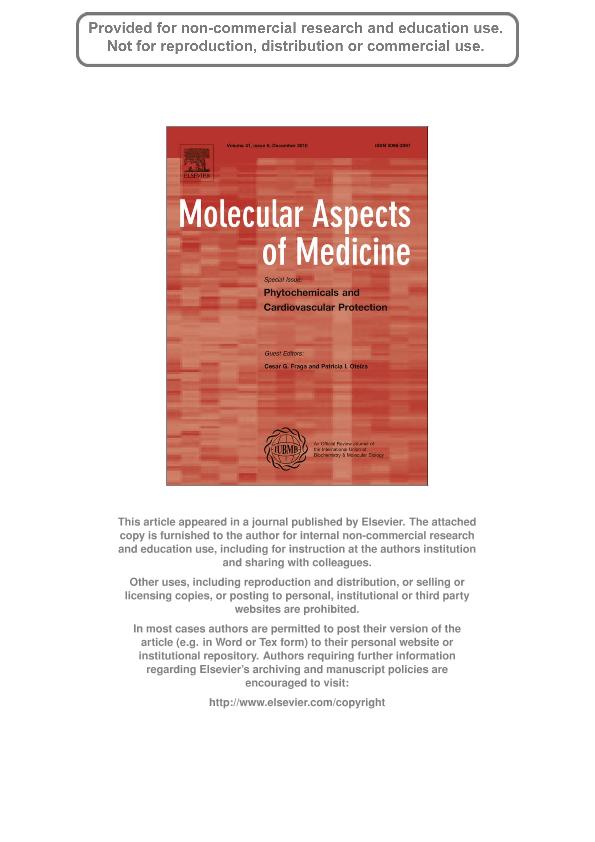Mostrar el registro sencillo del ítem
dc.contributor.author
Fraga, César Guillermo

dc.contributor.author
Galleano, Mónica Liliana

dc.contributor.author
Verstraeten, Sandra Viviana

dc.contributor.author
Oteiza, Patricia Isabel

dc.date.available
2020-04-13T16:21:10Z
dc.date.issued
2010-12
dc.identifier.citation
Fraga, César Guillermo; Galleano, Mónica Liliana; Verstraeten, Sandra Viviana; Oteiza, Patricia Isabel; Basic biochemical mechanisms behind the health benefits of polyphenols; Elsevier Science; Molecular Aspects Of Medicine; 31; 6; 12-2010; 435-445
dc.identifier.issn
0098-2997
dc.identifier.uri
http://hdl.handle.net/11336/102383
dc.description.abstract
Polyphenols and consequently many flavonoids have several beneficial actions on human health. However the actual molecular interactions of polyphenols with biological systems remain mostly speculative. This review addresses the potential mechanisms of action that have been so far identified, as well as the feasibility that they could occur in vivo. Those mechanisms include: i) non specific actions, based on chemical features common to most polyphenols, e.g. the presence of a phenol group to scavenge free radicals; and ii) specific mechanisms; based on particular structural and conformational characteristics of select polyphenols and the biological target, e.g. proteins, or defined membrane domains. A better knowledge about the nature and biological consequences of polyphenol interactions with cell components will certainly contribute to develop nutritional and pharmacological strategies oriented to prevent the onset and/or the consequences of human disease. health. However the actual molecular interactions of polyphenols with biological systems remain mostly speculative. This review addresses the potential mechanisms of action that have been so far identified, as well as the feasibility that they could occur in vivo. Those mechanisms include: i) non specific actions, based on chemical features common to most polyphenols, e.g. the presence of a phenol group to scavenge free radicals; and ii) specific mechanisms; based on particular structural and conformational characteristics of select polyphenols and the biological target, e.g. proteins, or defined membrane domains. A better knowledge about the nature and biological consequences of polyphenol interactions with cell components will certainly contribute to develop nutritional and pharmacological strategies oriented to prevent the onset and/or the consequences of human disease.
dc.format
application/pdf
dc.language.iso
eng
dc.publisher
Elsevier Science

dc.rights
info:eu-repo/semantics/openAccess
dc.rights.uri
https://creativecommons.org/licenses/by-nc-sa/2.5/ar/
dc.subject
antioxidants
dc.subject
flavonoids
dc.subject
phytochemicals
dc.subject
hypertension
dc.subject.classification
Bioquímica y Biología Molecular

dc.subject.classification
Medicina Básica

dc.subject.classification
CIENCIAS MÉDICAS Y DE LA SALUD

dc.title
Basic biochemical mechanisms behind the health benefits of polyphenols
dc.type
info:eu-repo/semantics/article
dc.type
info:ar-repo/semantics/artículo
dc.type
info:eu-repo/semantics/publishedVersion
dc.date.updated
2020-04-01T18:05:36Z
dc.journal.volume
31
dc.journal.number
6
dc.journal.pagination
435-445
dc.journal.pais
Países Bajos

dc.journal.ciudad
Amsterdam
dc.description.fil
Fil: Fraga, César Guillermo. Universidad de Buenos Aires. Facultad de Farmacia y Bioquímica; Argentina. University of California; Estados Unidos. Consejo Nacional de Investigaciones Científicas y Técnicas; Argentina
dc.description.fil
Fil: Galleano, Mónica Liliana. Universidad de Buenos Aires. Facultad de Farmacia y Bioquímica; Argentina. Consejo Nacional de Investigaciones Científicas y Técnicas; Argentina
dc.description.fil
Fil: Verstraeten, Sandra Viviana. Consejo Nacional de Investigaciones Científicas y Técnicas. Oficina de Coordinación Administrativa Houssay. Instituto de Química y Físico-Química Biológicas "Prof. Alejandro C. Paladini". Universidad de Buenos Aires. Facultad de Farmacia y Bioquímica. Instituto de Química y Físico-Química Biológicas; Argentina. University of California; Estados Unidos
dc.description.fil
Fil: Oteiza, Patricia Isabel. Consejo Nacional de Investigaciones Científicas y Técnicas. Oficina de Coordinación Administrativa Houssay. Instituto de Química y Físico-Química Biológicas "Prof. Alejandro C. Paladini". Universidad de Buenos Aires. Facultad de Farmacia y Bioquímica. Instituto de Química y Físico-Química Biológicas; Argentina. University of California; Estados Unidos
dc.journal.title
Molecular Aspects Of Medicine

dc.relation.alternativeid
info:eu-repo/semantics/altIdentifier/url/https://www.sciencedirect.com/science/article/pii/S0098299710000750
dc.relation.alternativeid
info:eu-repo/semantics/altIdentifier/doi/http://dx.doi.org/10.1016/j.mam.2010.09.006
Archivos asociados
